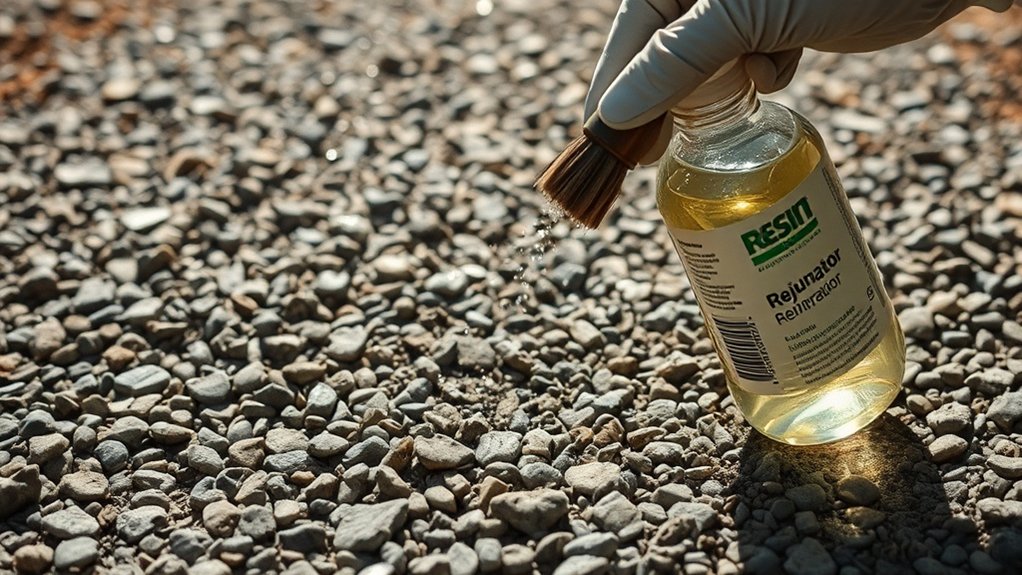To restore the shine of resin-bound gravel, begin by sweeping and rinsing the surface to eliminate dirt and debris. For tough stains, use a mild, pH-neutral detergent and a stiff brush. If necessary, consider a specialised cleaner like BOUNDCLEAN. Once cleaned, resealing is crucial to maintain the gloss and protect against future wear. Check for any stains and treat them as required. Keep exploring more effective techniques for longer-lasting results.
Key Takeaways
- Regularly sweep the surface with a stiff broom and rinse with a hose to keep it clean and prevent dullness.
- For stubborn grime, use a mild, pH-neutral detergent applied with a stiff-bristle brush in circular motions.
- Pressure wash the gravel at settings below 150 bar to restore its shine without causing damage.
- After cleaning, apply a professional sealer like BOUNDSEAL to boost gloss and protect against UV damage.
- Carry out regular maintenance checks and look for cracks or stains that may need professional attention.
Understanding the Causes of Dullness in Resin-Bound Gravel
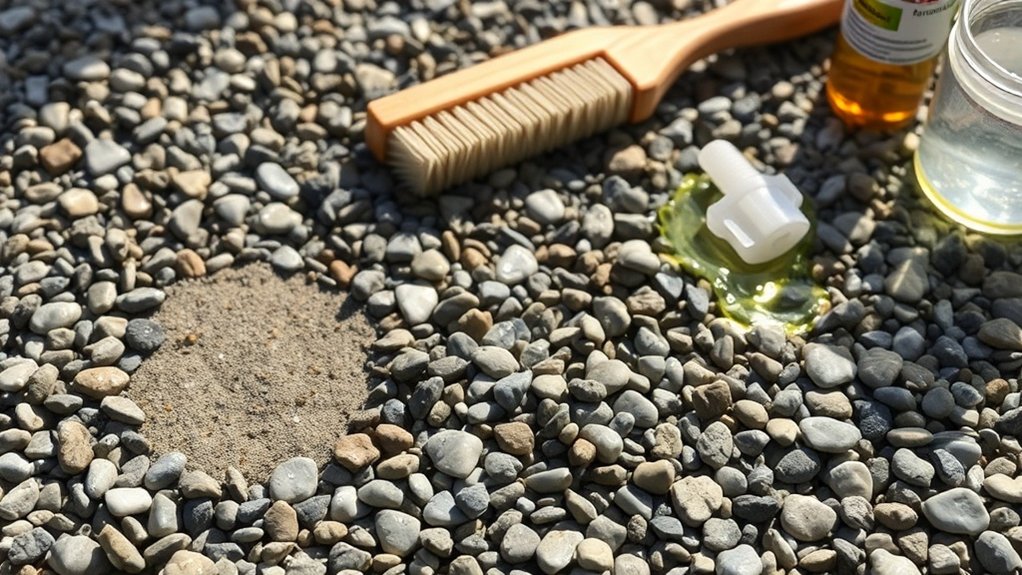
If you notice dullness in your resin-bound gravel, it’s important to identify the causes.
Environmental factors, especially exposure to UV light, significantly affect the resin’s chemistry, causing pigment breakdown and fading colours. Even with UV protection, prolonged sunlight can dull the vibrancy of your surface. Additionally, the constant cycle of wetting and drying due to weather can wear down the resin, while temperature changes can weaken the bond between the resin and aggregate. Air pollution and other contaminants can lead to further loss of gloss. Darker colors tend to fade more quickly, which highlights the need for quality materials and proper techniques. Finally, poor installation practices, such as incorrect resin-to-aggregate ratios or insufficient surface preparation, can worsen the dullness. This highlights the need for quality materials and proper techniques. Regular maintenance practices, such as sweeping regularly, can also help mitigate some of these effects and prolong the life of your resin-bound gravel.
Effective Cleaning Techniques for Restoring Shine
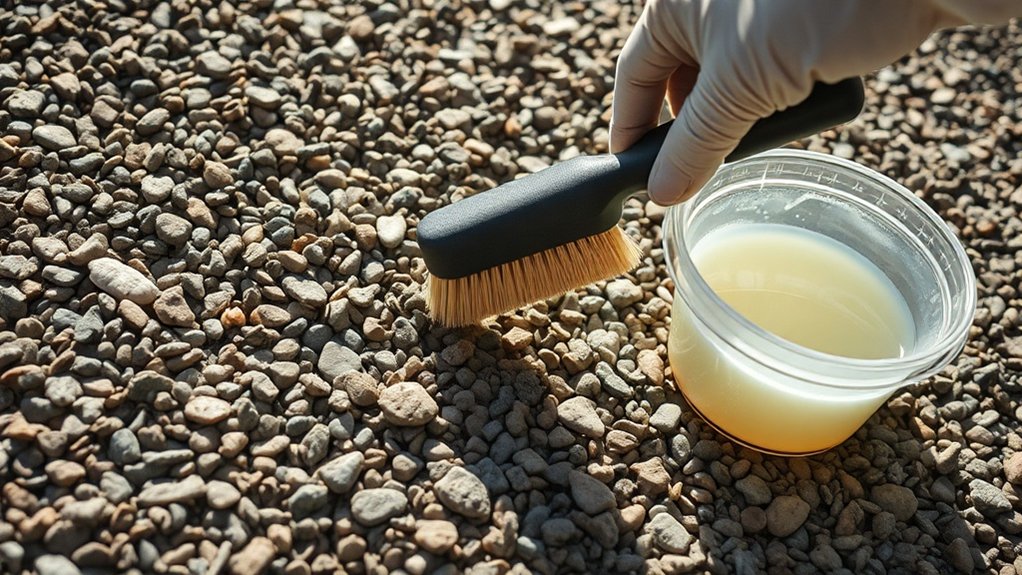
To restore the shine of your resin-bound gravel, begin with regular cleaning to prevent dirt accumulation and keep it looking its best. Use specific stain removal techniques for different types of marks, and opt for cleaning products that are safe for the surface. Implementing regular maintenance is crucial for preserving the appearance and longevity of your driveway. Additionally, weekly sweeping can help prevent moss growth and maintain drainage, ensuring your resin-bound gravel remains in excellent condition.
Regular Cleaning Methods
Regular cleaning is crucial for keeping resin-bound gravel surfaces looking good and functioning well. To protect your surface, set a regular cleaning schedule.
Begin by sweeping the area with a stiff broom to remove debris and prevent moss. After sweeping, hose the surface down to wash away dust and leftover grit, then allow it to dry completely. Regular maintenance, including cleaning spills immediately can also prevent staining and discoloration.
For tougher grime, use a mild, pH-neutral detergent and scrub with a stiff brush. If needed, you can pressure wash at safe settings—just keep the pressure below 150 bar. Additionally, regularly sweeping the surface helps remove leaves and debris that can cause discoloration.
After cleaning, check the surface once it’s dry to see if the shine has returned and if any spots need extra attention.
Stain Removal Techniques
Effective stain removal techniques are crucial for keeping resin-bound gravel surfaces looking their best. Here’s how to tackle stains effectively:
- Quickly blot any oil or grease spills with an absorbent cloth or paper towel.
- Address organic stains, such as bird droppings or algae, as soon as possible to prevent them from setting in.
- Use warm, soapy water or a mild detergent to scrub the area after blotting.
- For tougher stains, consider using specialised treatments like degreasers or oxalic acid.
- Regularly inspect the surface to catch any early signs of staining.
In addition to these stain removal methods, implementing prevention strategies will help maintain your gravel’s appearance.
Recommended Cleaning Products
When looking for the best cleaning products to restore the shine of your resin-bound gravel, it’s important to select those specifically designed for this type of surface.
BOUNDCLEAN by PERMABOUND is a professional cleaner that effectively removes dirt, algae, and grime while preventing regrowth. Its eco-friendly formula is safe for both users and the environment.
For regular cleaning, pH-neutral products like mild dish soap can help maintain shine without damaging the resin. Steer clear of harsh chemicals, as they can dull the surface.
Cleaning regularly ensures the products work effectively, and for stubborn dirt, use a stiff-bristled brush.
After cleaning, applying a professional sealer like BOUNDSEAL will help keep your resin-bound gravel looking its best.
Importance of Sealing and Protective Treatments
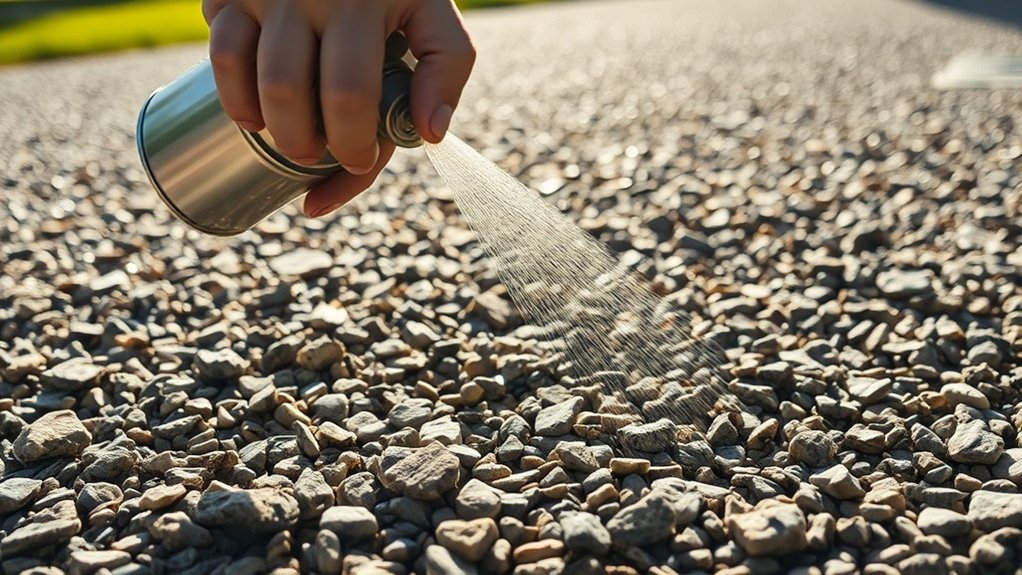
Sealing and protective treatments are crucial for keeping resin-bound gravel surfaces looking good and functioning well. By using these solutions, you can prolong the life and appearance of your gravel.
Here are some key benefits to consider:
- Enhances resistance to weather and UV damage, maintaining gloss and colour.
- Provides a barrier against stains from oils and other contaminants.
- Prevents water pooling, which helps reduce wear and erosion.
- Restores vibrancy and shine through regular resealing.
- Minimises fading in harsh weather conditions.
Applying UV-resistant coatings and hydrophobic treatments makes cleaning easier and strengthens your gravel against environmental damage, ensuring it remains attractive and functional for years.
Repairing Physical Damage to the Surface
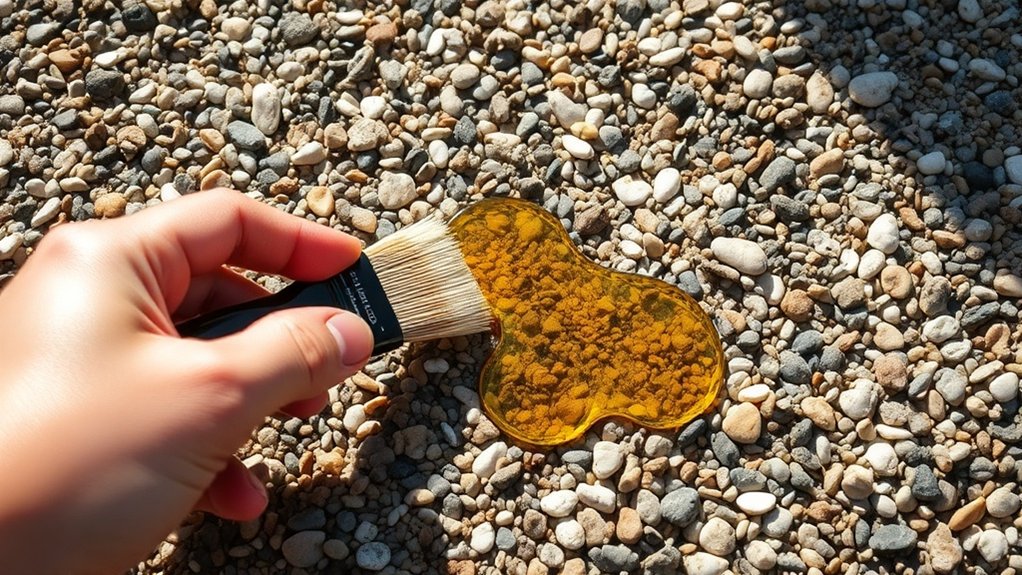
To restore a resin-bound gravel surface effectively, start by assessing the damage, looking for cracks, chips, or areas where the material has come loose.
Clean the area thoroughly to remove any dirt or debris. Use sandpaper or a grinder to smooth the edges around the damaged spots for better adhesion.
Prepare your resin and aggregate, ensuring they match the original materials closely. Carefully apply the mixture, filling the affected areas and creating a keyed edge for a secure bond.
Allow the repair to cure completely, then check for levelness, sanding or adding more resin as necessary.
This careful method ensures a durable, seamless repair that keeps your surface looking its best.
Factors Influencing Long-Term Shine Retention
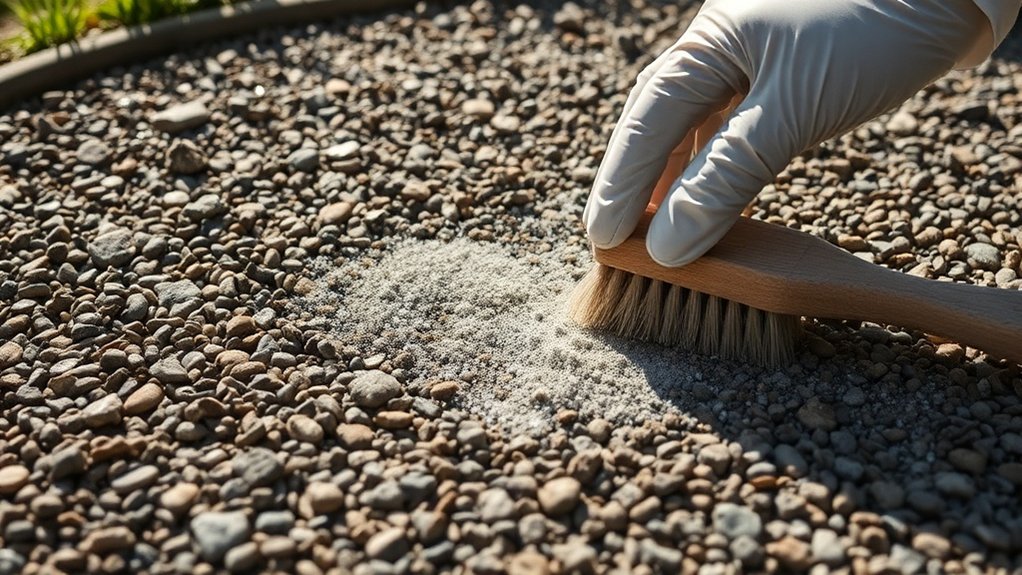
After addressing physical damage to your resin-bound gravel surface, it’s essential to consider factors that affect its long-term shine retention. Here are the key aspects:
- UV resistance: Choose a resin formulation that prevents yellowing and brittleness from sun exposure.
- Quality of aggregate: Ensure high-quality materials and proper substrate preparation for a consistent finish.
- Installation technique: Skilled installation is crucial; avoiding inconsistencies and moisture during curing can make a significant difference.
- Environmental factors: Be aware that air pollution and chemical exposure can lead to surface degradation over time.
- Regular maintenance: Implement consistent cleaning and care practices to keep your gravel looking fresh and vibrant.
Preventive Maintenance Practices
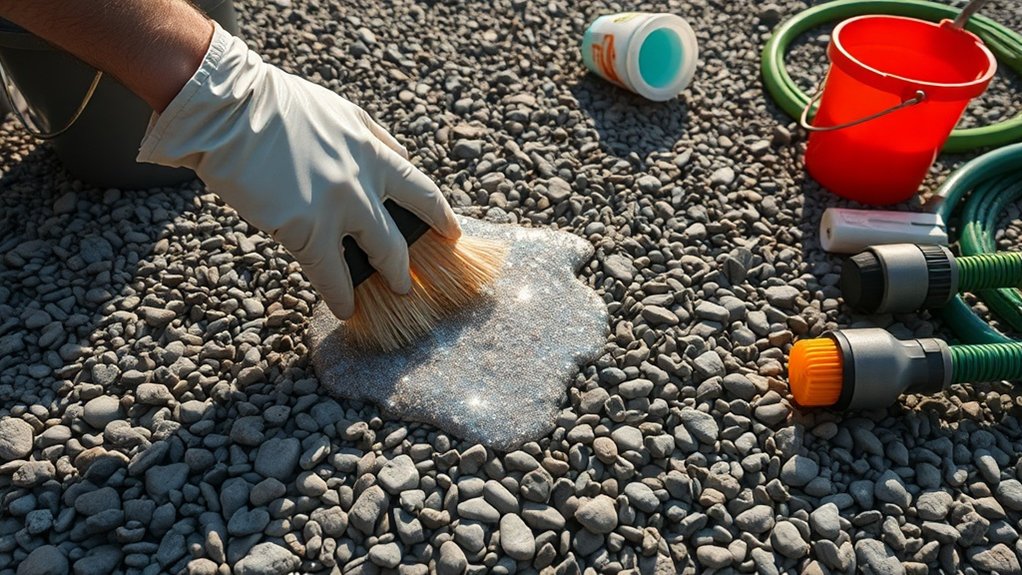
To maintain the appearance and structural integrity of your resin-bound gravel surface, it’s important to adopt preventive maintenance practices for long-term performance. Establish a maintenance schedule that includes regular inspections, debris removal, and timely repairs. Here’s a straightforward guide for your routine:
| Task | Frequency | Purpose |
|---|---|---|
| Sweep or blow debris | Weekly | Prevents dirt accumulation |
| Inspect for damage | Monthly | Identifies issues early |
| Remove weeds by hand | As needed | Stops regrowth |
| Apply sealant | Every 5-8 years | Protects surface from damage |
| Monitor drainage | Seasonal | Ensures proper water flow |
Identifying and Treating Stains
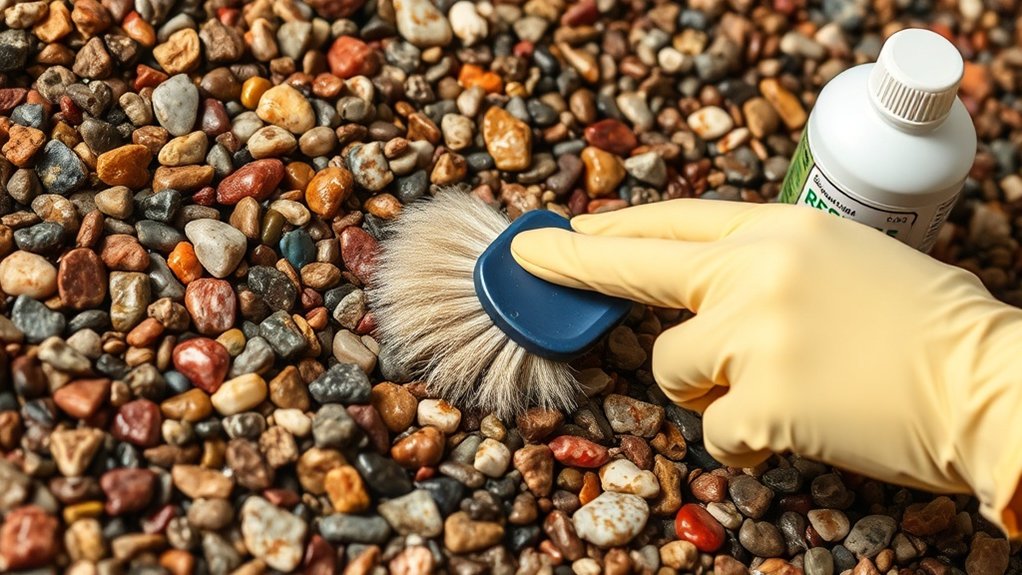
When it comes to resin-bound gravel, identifying the type of stain is crucial for effective cleaning.
Common stains include oil and grease, organic matter, rust, general dirt, and sticky residues, each needing a specific approach.
For instance, oil stains may require a degreaser, while rust can be tackled with a rust remover.
Knowing how to deal with these stains will help you keep your surface looking its best and maintain its integrity.
Common Stain Types
Four common types of stains can affect resin-bound gravel, each needing specific identification and treatment methods.
Recognising these stains is crucial for effective treatment:
- Mineral Stains: These appear as reddish-brown rust marks caused by iron or metal oxidation.
- Organic Stains: Look out for brown, yellow, or green discolouration from leaves, bird droppings, or pet urine.
- Chemical Stains: Dark patches from oil, petrol, or cleaning agents can dull the surface.
- UV-Induced Discolouration: Colours may fade due to prolonged exposure to UV light, particularly in materials that lack UV resistance.
- Surface Clouding: A milky film may form from moisture during curing, which can’t be reversed.
Identifying these stains quickly will help you choose the right treatment options to restore your resin-bound gravel effectively.
Cleaning Methods Explained
To clean resin-bound gravel effectively, first identify the types of stains on the surface. Regularly inspect for discolouration, splotches, or grime. Light patches may indicate mineral deposits, while dark areas often suggest oil spills. Tyre marks require special attention to avoid permanent staining.
Start by sweeping the area to remove debris, then rinse with a garden hose. For routine cleaning, use a pH-neutral detergent mixed with warm water.
For spot cleaning, apply the solution with a stiff-bristle brush, scrubbing in circular motions. Let the solution sit on stubborn stains for 5–10 minutes before scrubbing again.
Finally, check the surface texture to ensure all stains are addressed, repeating the process if necessary for the best results.
Preventing Future Stains
Preventing Stains on Resin-Bound Gravel
Stains are a common challenge for resin-bound gravel surfaces, but with some simple steps, you can prevent them effectively. Here’s how to keep your gravel looking great:
- Sweep away debris and leaves regularly.
- Wash the surface with medium-pressure every six months to remove dirt.
- Apply resin-safe protective coatings that offer UV protection.
- Use non-corrosive de-icers and plastic tools when clearing snow.
- Ensure proper mixing and curing of the resin to avoid clouding.
Choosing the Right Products for Restoration
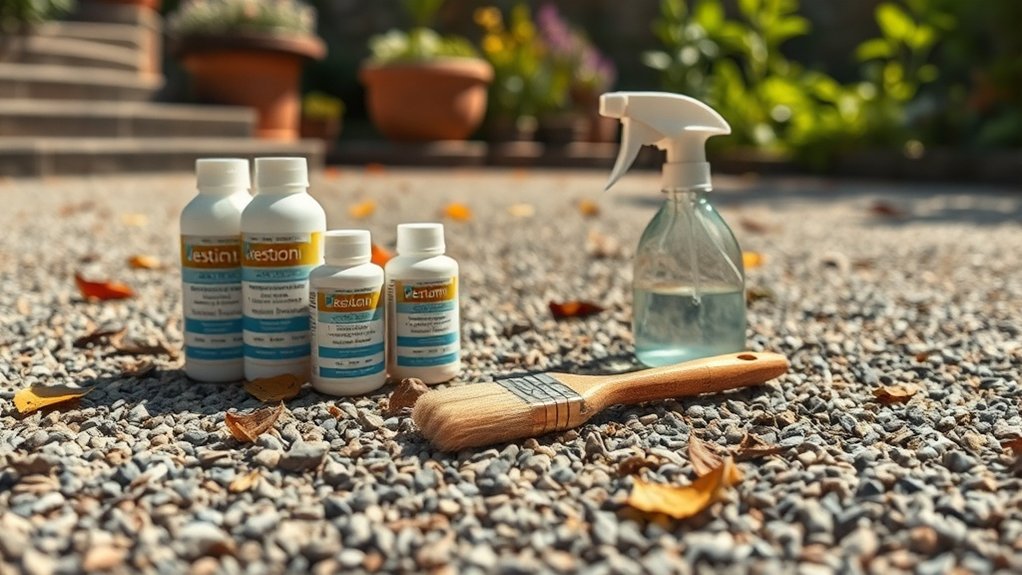
Selecting the right products for restoring resin-bound gravel is crucial for achieving a durable and visually appealing finish.
Start by choosing the right resin: polyurethane or UV-stable resins are your best bets as they offer UV resistance and prevent yellowing over time. It’s important to ensure the resin is compatible with your existing gravel aggregate to guarantee proper adhesion and a seamless blend with the original surface.
When selecting aggregate, try to match the colour and size as closely as possible to maintain consistency in appearance.
Consider using repair kits that include both resin and aggregate for precise mixing ratios and optimal bonding.
Lastly, prepare the surface thoroughly using a pressure washer and sandpaper to enhance adhesion. A clean and dry base is essential for effective repairs.
When to Seek Professional Help
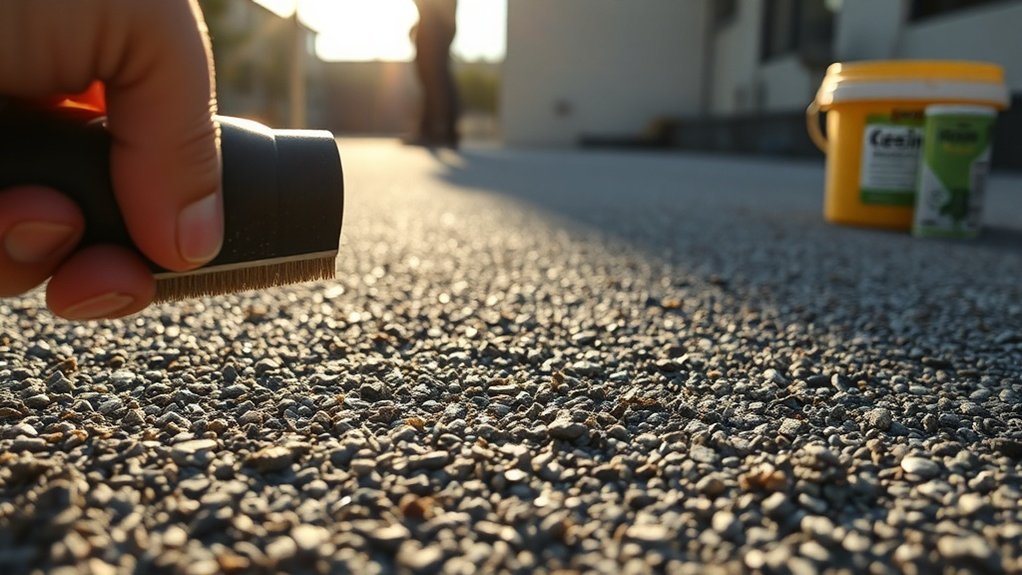
When dealing with significant damage to your resin-bound gravel, it’s important to know when to call in the professionals. Here are some key signs to look out for:
- Cracks that are wider or deeper than 20mm should be assessed by an expert.
- Damage that impacts the underlying macadam or sub-base needs immediate attention.
- Oil stains on the resin surface can complicate repairs and require professional cleaning.
- Large areas showing surface deterioration or stubborn discolouration indicate a need for expert help.
- Signs of ground subsidence must be evaluated for structural safety.
If you notice any of these issues, seeking a professional assessment is crucial.
Experts have the right tools and knowledge to carry out proper repairs, preventing further damage. Tackling these problems early with skilled contractors can save you from expensive replacements later on.
Don’t hesitate to seek help when you need it.
Frequently Asked Questions
Can I Use Vinegar for Cleaning Resin-Bound Gravel?
Yes, you can use vinegar to clean resin-bound gravel. Its mild acidity helps break down dirt and can prevent moss growth. Just remember to dilute it with water and test a small area first to avoid any damage.
How Often Should I Reseal My Resin-Bound Gravel?
You should reseal your resin-bound gravel every 1 to 3 years, depending on how much it’s used and the environmental conditions. For instance, areas with heavy foot traffic or extreme weather may require more frequent sealing. Regular maintenance and visual checks will help you decide the best timing for resealing, ensuring your surface remains durable and looks great.
Is It Safe to Pressure Wash Resin-Bound Gravel?
Pressure washing resin-bound gravel is akin to cleaning a delicate painting; it needs to be done with care. To maintain your resin surface effectively, use gentle cleaning methods. Keep the pressure below 150 bar and maintain a safe distance to prevent damage.
What Are the Signs of Poor Installation?
Signs of poor installation include uneven surfaces due to mistakes made during the process and drainage problems, such as standing water. Look out for loose stones, cracks, or discolouration, which can indicate poor mixing or improper curing techniques.
Can I Use Bleach to Remove Stains?
Yes, you can use bleach to remove stains from resin-bound gravel, but it’s important to dilute it properly and rinse it off thoroughly afterwards. For long-term care, consider using safer cleaning products to protect your resin surface.
Conclusion
To restore the shine of resin-bound gravel, you’ll need to take a comprehensive approach that includes thorough cleaning and regular upkeep. Many think that just applying a sealant will fix the dullness, but it’s crucial to tackle underlying issues like stains and any physical damage first. For example, if your gravel has oil stains from a car, simply sealing it won’t hide the problem. By addressing these factors and using the right methods, you can maintain the visual appeal of your gravel for longer. If you’re uncertain or the issue continues, it may be wise to consult a professional.
